Conrad Schumann leapt over the nascent Berlin Wall on August 15, 1961 because he didn't want to "live enclosed" in East Germany — a powerful moment famously captured by a nearby photographer.
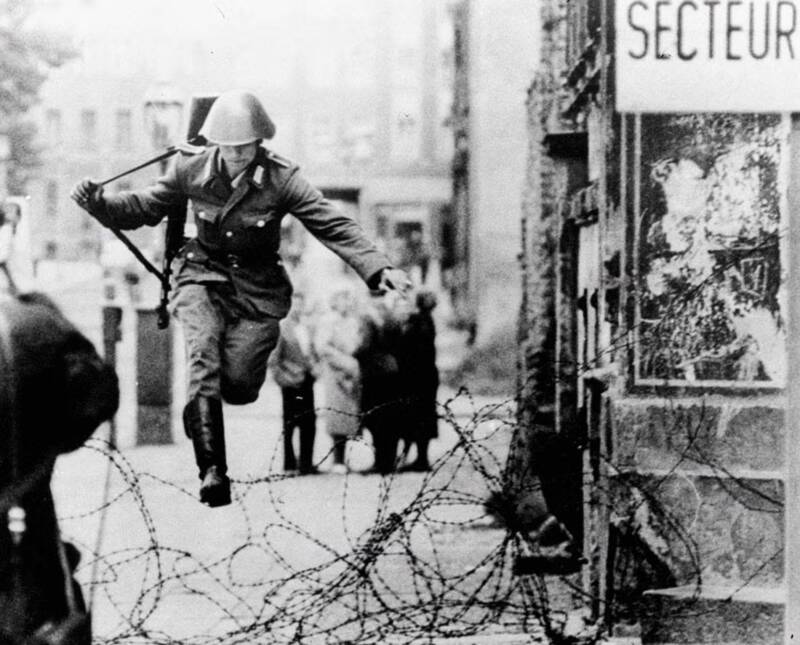
Public DomainThe famous photo of Hans Conrad Schumann leaping into West Germany.
By August 1961, tensions were high in Berlin. The city had been cut in two by the creation of West Germany and East Germany and, that summer, East Germany began to build a wall to stop its people from pouring into the West. But just days into the construction of the Berlin Wall, a young East German soldier named Hans Conrad Schumann leapt over it.
Schumann hadn’t thought deeply about his decision, and he didn’t expect that it would be recorded. As it so happened, a photographer named Peter Leibing captured the exact moment that Schumann jumped over a piece of barbed wire into West Germany, and the resulting image, Leap Into Freedom, became an iconic photo of the Cold War.
But that wasn’t the end of Conrad Schumann’s story.
How Hans Conrad Schumann Ended Up In Berlin
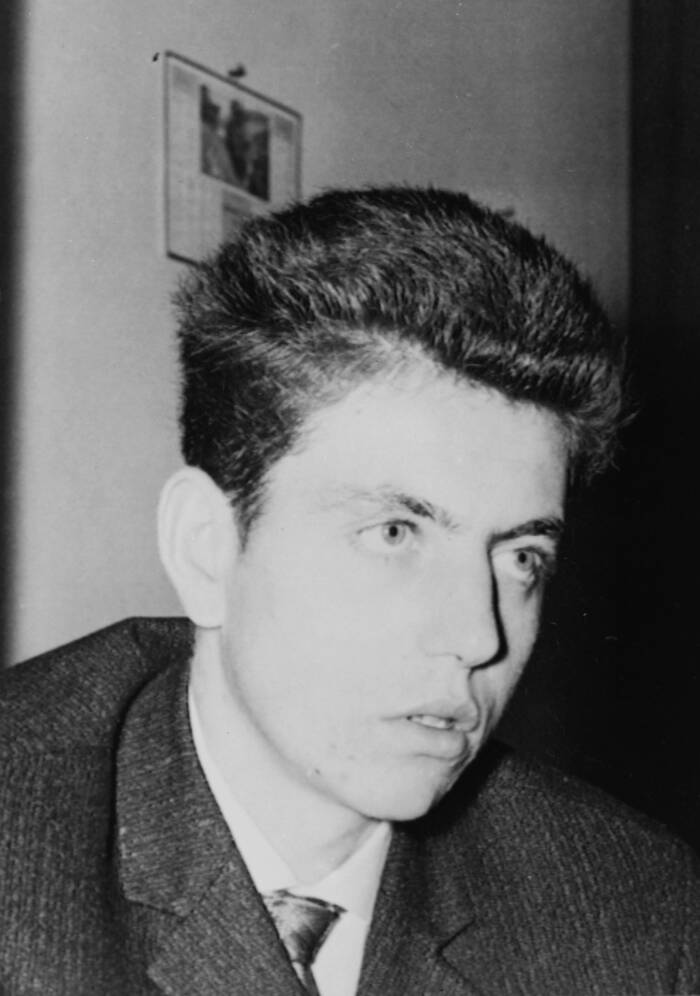
Smith Archive / Alamy Stock PhotoConrad Schumann in 1961, shortly after he leapt over the nascent Berlin Wall into West Germany.
Hans Conrad Schumann was born on March 28, 1942, in Saxony, Germany. Coming of age in the wake of World War II, he initially planned to train as a shepherd. However, Schumann soon realized that he would make more money as a police officer, and enlisted in the East German Volkspolizei-Bereitschaften, the paramilitary wing of the Volkspolizei.
Schumann trained in Dresden, and then attended a non-commissioned officers’ college in Potsdam. Soon after, the 19-year-old volunteered for service in Berlin, and headed to the city in the summer of 1961.
It was a fraught time to be in the German capital. The city was divided in two by the division of East Germany and West Germany, and by the time Schumann arrived in August, East Germany had begun constructing a wall to stop its citizens from flowing into the West. The wall would become the Berlin Wall, which would cut across the divided city until in 1989.
But when Schumann began his patrol, it was little more than a string of barbed wire.
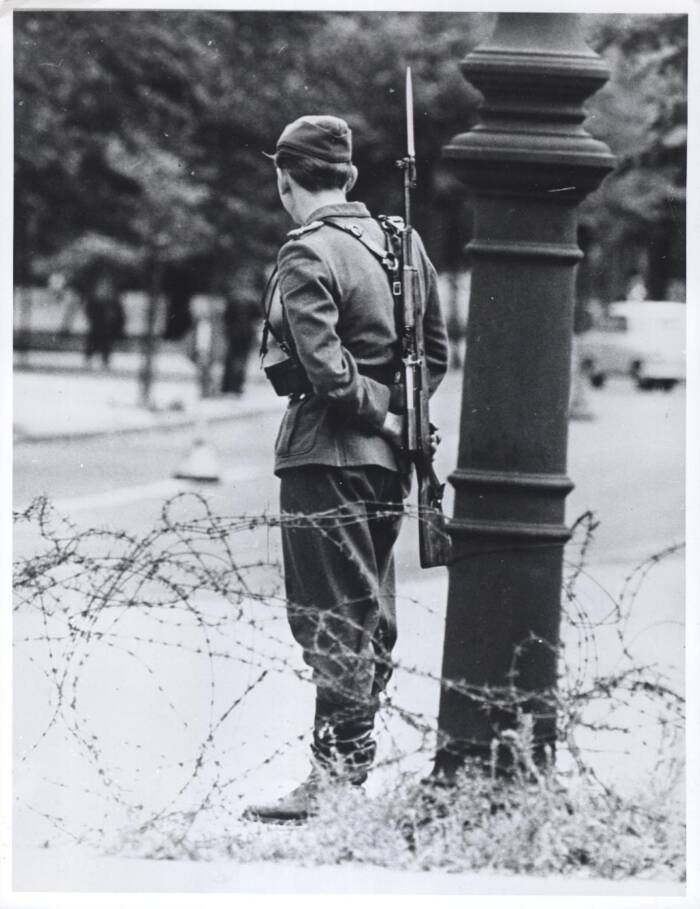
Central Intelligence Agency An East German soldier stands guard at the Berlin Wall, when it was still mostly made of barbed wire. August 1961.
Hans Conrad Schumann didn’t know it then, but he would become forever linked with the nascent Berlin Wall and the Cold War.
The ‘Leap Into Freedom Photograph’
On August 15, 1961, the third day of the Berlin Wall’s construction, Hans Conrad Schumann was sent to patrol the corner of Ruppiner Straße and Bernauer Straße. He and his fellow guards were instructed to “take control and protect the border from the enemies of socialism.”
At first, things were quiet.
“We stood around looking pretty stupid at first,” Schumann later recalled. “Nobody had told us how that’s done: taking control of a border.”
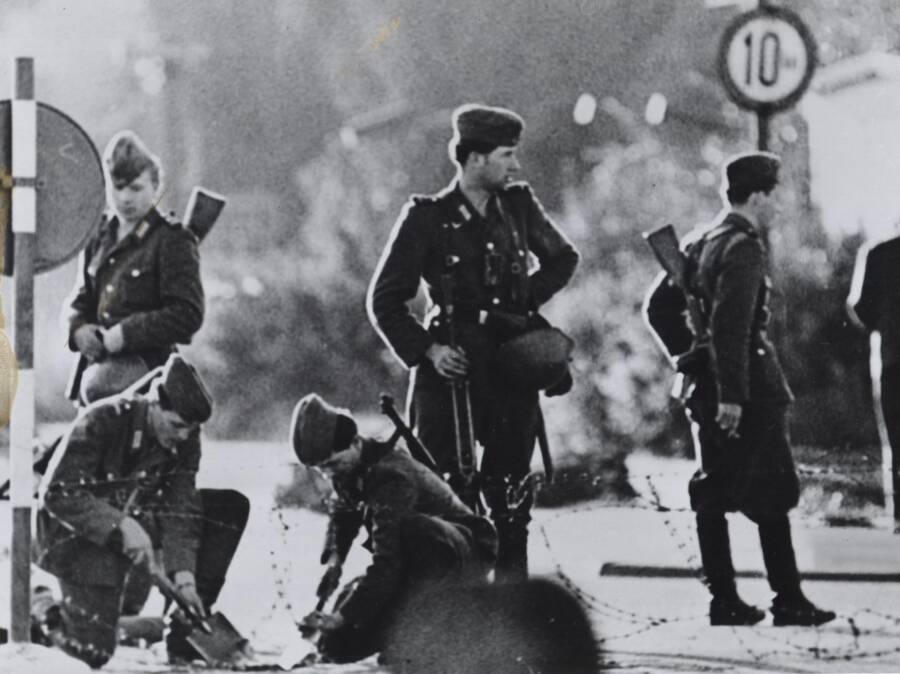
Central Intelligence Agency East German soldiers building the Berlin Wall. August 1961.
But tensions soon began to rise. West Berliners weren’t happy about the wall, which not only divided the city in two but also separated family members. Some people shouted at Schumann and his fellow soldiers, calling them “pigs” and “traitors.” Meanwhile, Schumann watched heartbreaking scenes of family separation as they unfolded.
According to Wall: The Inside Story of Divided Berlin by Peter Wyden, he witnessed a young woman passing a bouquet of flowers across the makeshift wall to her mother. Pointing toward Schumann, the woman stated: “Those over there, they won’t let me across anymore.”
Such scenes began to give Schumann a bad feeling. Then, around 4 p.m. in the afternoon, he saw a convoy of trucks with building materials. He realized that if he didn’t act, he would “live enclosed” in East Germany.
So Hans Conrad Schumann decided to jump across the barbed wire.
“Many people were standing around, and that was good, because they distracted my colleagues,” Schumann recalled, according to The Independent in 1998. “My nerves were at breaking point. I was very afraid.”
Meanwhile, according to the German site Deutsche Welle, photographer Peter Leibing had begun to notice Schumann, who was nervously chain-smoking cigarettes. The photographer was watching Schumann when Schumann broke toward the wall. Leibing had experience photographing horses, and he captured Schumann in just the same way — mid jump.
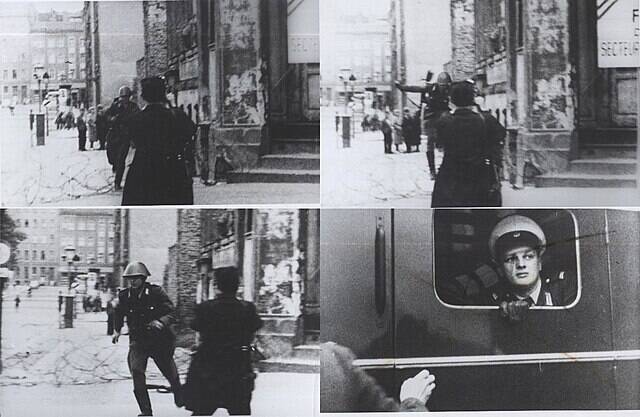
Central Intelligence AgencySchumann leaves in a police van after entering West Berlin.
In instant, Hans Conrad Schumann had hopped over the wire barrier and run into a nearby police van. Schumann had made it to West Germany. And Leibing had immortalized the moment of his escape.
A Tragic End — And An Enduring Legacy
Liebing’s photograph of Hans Conrad Schumann, called Leap Into Freedom, came to symbolize the Cold War struggle between East and West Germany. For many, it represented escaping oppression for freedom.
However, Schumann’s life in West Germany wasn’t always easy. Though he fell in love and got married, Schumann struggled with alcoholism and drifted from various jobs. Meanwhile, he was haunted by fear that the Stasi, the East German secret police, would come and find him.
And Schumann’s fears weren’t entirely unfounded.

dpa picture alliance / Alamy Stock PhotoConrad Schumann poses in front of the Leap Into Freedom photo that made him famous.
The letters he wrote to his family members back in East Germany were routinely intercepted by the Stasi. The secret police wanted to lure him back to East Germany, and involved Schumann’s family in their plot to do so.
“Only much later did I realise how dangerous this situation was,” Schumann recalled in a 1994 interview. “I did not know that the letters my parents were writing me were dictated by the Stasi.”
Once the Berlin Wall fell on Nov. 9, 1989, Schumann could traveled back east to visit the friends and family he’d left behind. However, many refused to speak with him; they saw him as a traitor.
And tragically, just nine years after the reunification of Germany, Hans Conrad Schumann died of suicide at his home on June, 20 1998. He was 56 years old, and had reportedly struggled with depression.
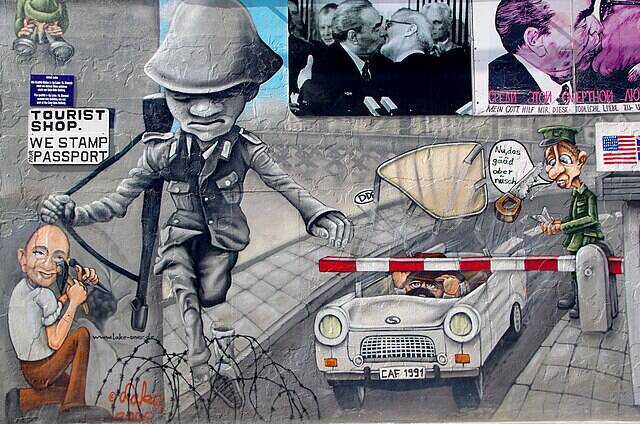
Wikimedia CommonsGraffiti art on the Berlin Wall inspired by the Leap Into Freedom photograph.
Despite his tragic end, however, the legacy of Schumann’s bold action that August afternoon continues on. In one leap, he became a symbol for escaping oppressive governments — and his action embodied the human desire to escape captivity. Sadly, it took the fall of East Germany for Schumann to finally achieve the freedom he’d chased in 1961.
“Only since 9 November 1989 have I felt truly free,” Schumann later declared.
After learning the story of Hans Conrad Schumann and the ‘Leap Into Freedom’ photograph from 1961, look through this astounding collection of photos which capture the fall of the Soviet Union. Or, look through these Soviet propaganda posters from the height of the Cold War.





